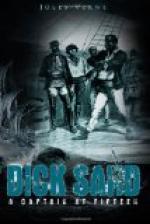After all, the African savages have no pockets, and how could they have any? This gives rise to the necessity of placing where they can their knives, pipes, and other customary objects. As for the neck, arms, wrists, legs, and ankles, these various parts of the body are undoubtedly destined to carry the copper and brass bracelets, the horns cut off and decorated with bright buttons, the rows of red pearls, called same-sames or “talakas,” and which were very fashionable. Besides, with these jewels, worn in profusion, the wealthy people of the place looked like traveling shrines.
Again, if nature gave the natives teeth, was it not that they could pull out the upper and lower incisors, file them in points, and curve them in sharp fangs like the fangs of a rattlesnake? If she has placed nails at the end of the fingers, is it not that they may grow so immoderately that the use of the hand is rendered almost impossible? If the skin, black or brown, covers the human frame, is it not so as to zebra it by “temmbos” or tattooings representing trees, birds, crescents, full moons, or waving lines, in which Livingstone thought he could trace the designs of ancient Egypt? This tattooing, done by fathers, is practised by means of a blue matter introduced into the incisions, and is “stereotyped” point by point on the bodies of the children, thus establishing to what tribe or to what family they belong. The coat-of-arms must be engraved on the breast, when it cannot be painted on the panel of a carriage.
Such are the native fashions in ornament. In regard to garments properly so called, they are summed up very easily; for the men, an apron of antelope leather, reaching to the knees, or perhaps a petticoat of a straw material of brilliant colors; for the women, a belt of pearls, supporting at the hips a green petticoat, embroidered in silk, ornamented with glass beads or coury; sometimes they wear garments made of “lambba,” a straw material, blue, black, and yellow, which is much prized by the natives of Zanzibar.
These, of course, are the negroes of the best families. The others, merchants, and slaves, are seldom clothed. The women generally act as porters, and reach the market with enormous baskets on their back, which they hold by means of a leathern strap passed over the forehead. Then, their places being taken, and the merchandise unpacked, they squat in their empty baskets.
The astonishing fertility of the country causes the choice alimentary produces to be brought to this “lakoni.” There were quantities of the rice which returns a hundred per cent., of the maize, which, in three crops in eight months, produces two hundred per cent., the sesamum, the pepper of Ouroua, stronger than the Cayenne, allspice, tapioca, sorghum, nutmegs, salt, and palm-oil.
Hundreds of goats were gathered there, hogs, sheep without wool, evidently of Tartar origin, quantities of poultry and fish. Specimens of pottery, very gracefully turned, attracted the eyes by their violent colors.




